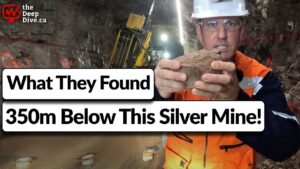Silver Bull Resources, Inc. has released the drill results for the seventh batch of drill holes from the underground drill program twinning a series of long holes in a high-grade silver zone situated at the eastern end of the Shallow silver zone on the Sierra Mojada project in Coahuila, Northern Mexico.
High-grade silver highlights from the seventh batch of 11 drill holes include:
Hole T12062: 43.65 metres at 193.3 grams per tonne silver (including 15 metres at 440.66 g/t Ag and five m at 241 g/t Ag);
Hole T12063: 20.00 metres at 124.2 g/t Ag (including 4.1 m at 346.6 g/t Ag);
Hole T12055: 26.05 metres at 90.40 g/t Ag (including two m at 884 g/t Ag);
Hole T12056: 36.50 metres at 80.23 g/t Ag (including 1.75 m at 581.43 g/t Ag and 2.3 m at 559.57 g/t Ag);
Hole T12064: 17.20 metres at 97.00 g/t Ag.
Silver Bull’s 3,000 m drill program in the high-grade silver zone consists of two underground “Termite” rigs twinning a series of long holes with up to 50 m long BQ-sized diamond core drill holes. The high-grade silver zone is hosted along a series of stacked east-west-trending structures with a combined traceable strike of approximately three kilometres at the eastern end of the Shallow silver zone. The purpose of the program is to increase confidence in a historical long hole data set which defines the high-grade silver zone and represents just under 38,000 metres of drilling which was either severally restricted or discarded in Silver Bull’s latest NI 43-101 resource report on the Shallow silver zone dated July 5, 2012. As announced in the Sept. 14, 2012, news release, Silver Bull has also expanded the underground drill program with an additional 2,000 metres of drilling to twin a series of long holes in the high-grade zinc zone, which sits adjacent to and below the silver mineralization. The twinning program in the zinc zone commenced on Oct. 8, 2012.
In addition to confirming the grade and tenor of the silver and zinc mineralization with the twinning program, much of the historical long hole data set ended in significant mineralization, so the program will also look to extend the mineralization by drilling longer holes. Due to the limited range of the Termite drills, and despite extending some holes by as much as 25 metres, some holes still end in mineralization.
This recent drilling, coupled with historical channel sampling and the company’s continuing underground mapping program, shows at least three distinct east-west-trending structures which host high-grade zones of silver mineralization. In places, these east-west-trending structures are crosscut by a series of northeast-trending faults resulting in a blowout, which yields a much wider zone of high-grade silver mineralization. A halo of silver mineralization grading up to 80 grams per tonne exists in between the high-grade zones and provides the tonnage for a potential bulk minable deposit in an open pit setting. The high-grade silver zone remains open in all directions and sits above and slightly adjacent to a significant body of zinc mineralization which has a present strike length of 1.5 kilometres and an average grade greater than 8 per cent zinc.
Hole ID Total From To Inter- Ag Zn
depth (m) (m) val g/t %
(m) (m)
T12055 41.50 0.00 26.05 26.05 90.40
36.00 40.15 4.15 15.02
T12056 56.85 0.00 36.50 36.50 80.23
47.00 51.95 4.95 53.85
T12057 51.05 0.00 38.00 38.00 77.24
T12058 62.00 9.60 12.10 2.50 10.84
T12059 55.30 0.00 25.00 25.00 59.68
T12060 16.55 0.00 15.35 15.35 27.76
T12061 13.45 0.00 13.45 13.45 81.74
T12062 43.65 0.00 43.65 43.65 193.38
T12063 23.75 0.00 20.00 20.00 124.20 4.58
T12064 20.70 0.00 17.20 17.20 97.00 3.18
T12065 50.30 0.00 20.25 20.25 47.89
About the Shallow silver zone
The Shallow silver zone is an oxide silver deposit (plus/minus zinc and lead), hosted along an east-west-trending fracture-karst system set in a cretaceous limestone-dolomite sequence. At a 20 g/t cut-off grade the Shallow silver zone has a measured resource of 3,023,000 tonnes at an average grade of 65 g/t for 6,343,000 contained troy ounces of silver, an indicated resource of 38.56 million tonnes at an average grade of 50 g/t for 61,694,000 contained troy ounces of silver, and an inferred resource of 6,491,000 tonnes at an average grade of 45 g/t for 9,478,000 contained troy ounces of silver. The mineralized body averages between 30 m to 90 m thick, up to 200 m wide and remains open in all directions. Approximately 60 per cent of the current 3.8-kilometre strike length is at or near surface before dipping at around 6.0 degrees to the east.
Zinc exploration target
In addition to the silver resource, Sierra Mojada also contains a significant zinc oxide exploration target which sits directly below and adjacent to the Shallow silver zone at its eastern end. The Red and White zinc zones have been identified through historical data containing 3,733 channels and 1,045 long holes over a 1.5 km strike length, but have too few core drill holes to presently delineate an NI 43-101-compliant mineral resource. The zinc mineralization consists of hemimorphite and lesser smithsonite, and forms a tabular body hosted mostly within the upper dolomite along the east-west-trending Sierra Mojada fault. It is located 600 metres from a functioning railway and has been periodically mined for zinc grading greater than 20 per cent over the last 100 years.
Sample analysis and quality assurance/quality control
All samples have been analyzed at ALS Chemex in North Vancouver, B.C., Canada. Samples are first tested with the ME-ICP41m procedure which analyzes for 35 elements using a near total aqua regia digestion. Samples with silver values above 100 parts per million are reanalyzed using the Ag-GRA21 procedure which is a fire assay with a gravimetric finish. Samples with zinc, lead and copper values above 10,000 ppm (1 per cent) are reanalyzed using the AA46 procedure which is a near total aqua regia digestion with an atomic absorption finish.
A rigorous procedure is in place regarding sample collection, chain of custody and data entry. Certified standards and blanks, as well as duplicate samples, are routinely inserted into all sample shipments to ensure integrity of the assay process.
The technical information of this news release has been reviewed and approved by Tim Barry, MAusIMM, a qualified person for the purposes of National Instrument 43-101.

















